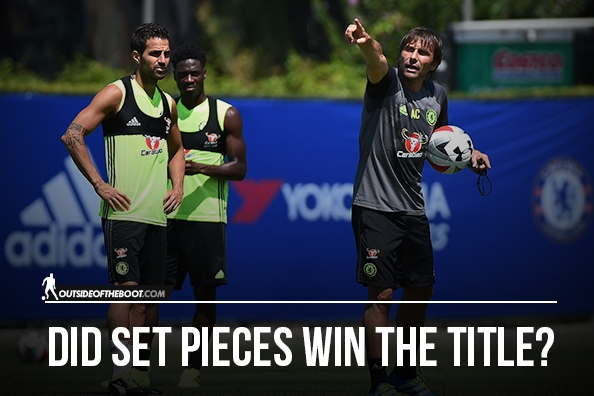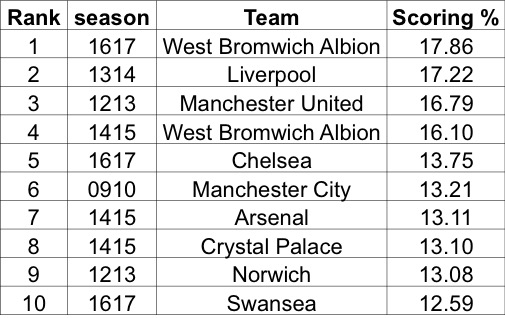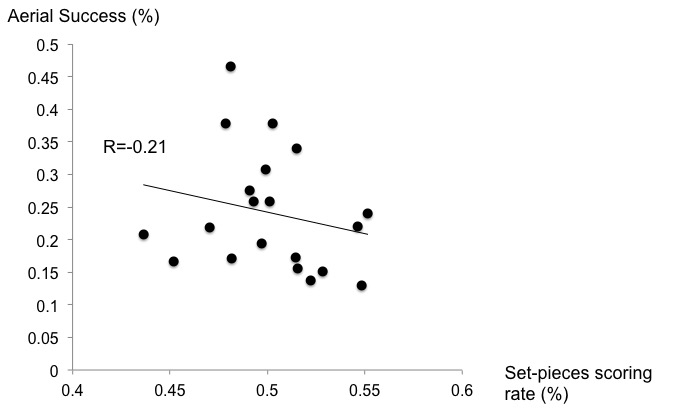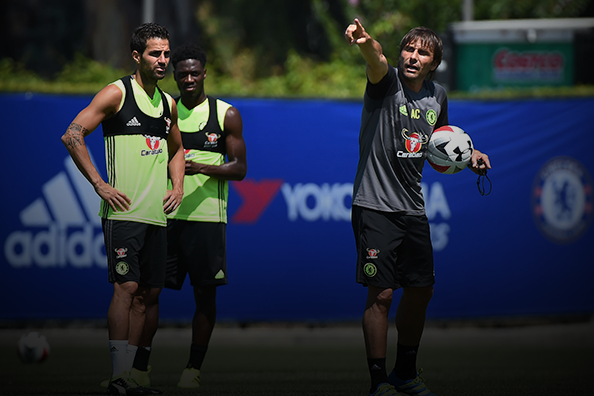Cheuk Hei Ho analyses the claim that set pieces won Chelsea the Premier League title via set pieces in detail.

After Manchester United beat Watford in February, Jose Mourinho told BBC that “Chelsea are a very good defensive team. They defend very well and with lots of players, and I think in this situation a very defensive team wins the title with counter-attack goals and set-piece goals, so I don’t believe that they will let it slip, but football is football.” But set-pieces such as free kicks and corners are difficult to score. How good was Chelsea in scoring from set-pieces last season?
Conte’s men are excellent at scoring from set-pieces.

Last season, Chelsea scored 22 goals out of 160 shots generated from set-pieces (13.75%), second behind West Brom (17.86%). They were so good that their conversion rate from set-pieces in 2016/17 was the 5th highest among 160 teams in the Premier League in the last eight seasons (the period for which data is available). Most of the shots generated from set-pieces such as corners involve crossing the balls into the box. Therefore, one would assume that a team will find it easier to score from the set-pieces if the team is dominant in the air over their opponent. But this assumption is not correct: Plotting the aerial success against set-pieces conversion rate reveals a negative correlation between the two parameters.

Therefore, to score from set-pieces like corners, Chelsea did not merely just cross the ball into the box and win the header. They either had excellent set-pieces takers, or they relied on some specific set-ups and tactics to organize the players in their set-pieces.
Here is how sophisticated Conte’s set up was during free-kicks and corners:
Willian (and Luiz) is a fantastic free-kick taker and has scored many free-kicks over the years.
But under Conte, Chelsea has used different tactics to facilitate their shots from the free-kicks:
Here four Chelsea players stood around Tottenham’s six-man wall. César Azpilicueta and Pedro were distractors. The important thing here is that Nemanja Matić and Marcos Alonso were positioned in-between the Tottenham’s players. Effectively they became part of the wall and provided the passage for Willian’s shot to go through the wall.
Eden Hazard and Willian were the distractors in the middle to occupy Sunderland’s defenders and to prevent them from helping the far side. Three of Sunderland’s defenders marked Terry, Diego Costa, and Alonso. Right before David Luiz crossed the ball into the box, Terry and Costa started the run. Alonso moved sideways to block his and Terry’s markers from moving past him, and the remaining Sunderland player was out-numbered by Terry and Costa. Costa eventually was free from to connect the cross. In this one move, Alonso acted as a “screener,” a concept analogous to the basketball who sets up the screen in a pick-&-roll move. This free-kick is a brilliant tactical set-up and execution.
Both Gary Cahill and Luiz moved towards the near-post first. Costa here acted as the screener to block Luiz’s marker. But all of these moves were distractions because the cross aimed at the far side and connected with Cahill. You can see how Ben Chilwell (#3) jerked towards the near post by the movements mentioned above and could not recover afterward.
Everton defended in a zonal marking scheme. Matic acted like a setter in the near-post to change the trajectory of the cross. Alonso distracted the players at the near-post. Luiz made a run as another distraction. The backward movement of Costa and forward movement of Cahill created a 2vs.1 advantage in the middle, and eventually, Costa scored.
Leicester City defended in a man-marking scheme. Matic was the setter to change the trajectory of the ball. Alonso, Cahill, Luiz acted as distractors, and they moved at the same time to pull all Leicester City’s defenders to the ball near-post. Costa was the only player moved to the opposite side where the ball would eventually reach. He was all alone to connect with the cross.
Chelsea’s usage of setters, screeners, and distractors is very elegant and creative. Many teams have used all the tactics mentioned above sporadically. But very few teams will use all of them at once, let alone doing it on a consistent basis. These tactics are one major reason why they score so many goals from free-kicks and corners. Conte’s work in the summer was excellent. Chelsea scored 9.32% of the shots they generated from set-pieces in 2015/16. The conversion rate jumped to 13.75% in 2016/17. The 4.43% increase is the 16th highest among 118 teams in Premier League for the last eight seasons. Conte deserved all the credit he got.
Was Jose Mourinho right to suggest that the goals from set-pieces and counter-attacks took Chelsea to the title?
Last season, Chelsea scored more goals from set-pieces and counter-attacks than everyone else. To evaluate if Mourinho’s statement is true, we need to ask if Chelsea scored from these situations like everybody else (league average), how many points they would have gotten, and if that amount of points was enough to win the Premier League. Chelsea scored 29 goals from set-pieces and counter-attacks and had 93 points last season. How many points would they have had if they would only score 14 goals (season average in Premier League) from set-pieces and counter-attacks? We need a mathematical model to measure how the 15 goal difference from set-pieces or counter-attacks would affect the number of points that Chelsea collected.
Goals would exert its greatest influence on points if they occurred in the matches that the outcome would have been altered by a single goal (0-0, 0-1, 3-2…etc). The higher the goals differential of a game, the more difficult it is for the goals to alter the outcome of the game. We can calculate the probability of goal occurrence by dividing the 15 goals difference among 38 league matches. However, this method over-estimates the effects of goal differential because it assumes that goals are evenly spread between league games. In other words, all games are decided by the same goal differential. If it was the case, Chelsea should have won every single league game because their goal differential is +2.2. In reality, goal differential is distributed in a normal distribution pattern.

Therefore, a lot of the goals were “useless” regarding points collection, because they do not impact the outcome of a game. To accurately determine how many points Chelsea collected from their set-pieces, we need a normal distribution model for this calculation.
Points = Goals x [(probability that a draw turned into a loss) x 1
+ (probability that a win turned into a draw) x 2
+ (probability that a win turned into a draw) x 3]
We do not need to explain the detail of this equation. But it takes into account on how single and double goals from set-pieces and counter-attacks impact the points Chelsea collected. For three goals from set-pieces and counter-attacks to happen in the same game is rare and we ignore it in this model. Here is the result of such model:

To check the accuracy of this model, we use it to predict how goals from set-pieces affect the points Chelsea collected. The model predicts that among those 22 goals, 8 of them would be able to alter the outcome of a game and generate 13 points. In fact, last season, seven Chelsea’s goals from set-pieces changed the results of 5 games and allowed Chelsea to gain 11 points. Therefore, our model is very accurate and only slightly overestimates the amounts of points that the goals would contribute to by less than 20%.
As mentioned before, if Chelsea were to score at an average number of goals from set-pieces and counter-attacks, they would score 15 fewer goals. Our model predicts that they would have nine fewer points. Under the same condition, Tottenham Hotspur would have two fewer points (they have scored only two more goals than average from set-pieces and counter-attacks). Therefore, both Chelsea and Tottenham would have had 84 points. Tottenham would have won the title based on their superior goal differential. However, bear in mind that our model over-estimates the amounts of points that the goals contribute to by about 20%. In that case, Chelsea would only score seven fewer points while Tottenham would have one fewer point, and Chelsea would still be the champion. (Chelsea would have 86 points while Tottenham would get 85 points) It ‘s hard to determine which situation would have happened. However, for a very high level of certainty, Chelsea’s excellent performances in set-pieces and counter-attacks help to swing the title to their side very significantly. In other words, Jose Mourinho was right.
We can use a similar method to predict how many goals Tottenham would have needed to score to beat Chelsea in the Premier League. The model predicts that Tottenham needed 16 more goals (or goal differential really) to have seven more points to catch up Chelsea. That is a very difficult improvement to make: If Tottenham were to score 16 more goals last season, their goal differential would have been 76, five goals more than the best goal differential record in Premier League history (Chelsea’ 71 in 2004-2005). Moreover, if they need just half of those 16 goals from the improvement of set-pieces, they would need to convert 4.9% more shots, an improvement that is higher than all but twelve teams in the Premier League for the last eight years. For Tottenham, something has to change if they are going to dethrone Chelsea next season.
























































